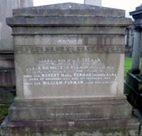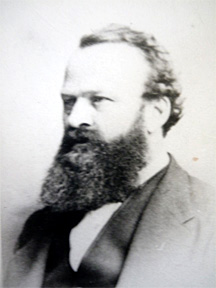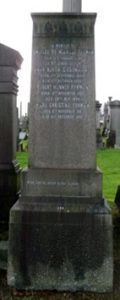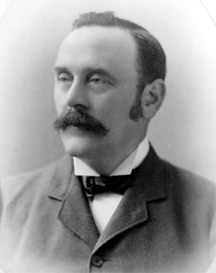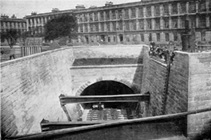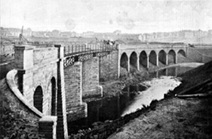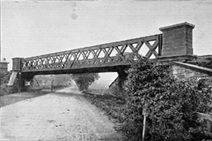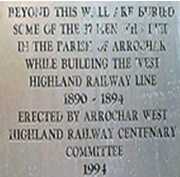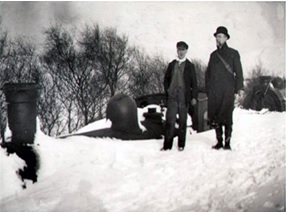Forman Family – Two Memorials
1st FORMAN MEMORIAL in Epsilon
In memory of ISABEL wife of J.R. FORMAN
born 7th March 1824, died 3rd July 1896,
JAMES RICHARDSON FORMAN Civil Engineer
born 29th January 1823, died 8th July 1900,
their son ROBERT HALL FORMAN Colonel R.A.M.C.
born 2nd November 1854, died 16th February 1928,
their son WILLIAM FORMAN born 1870, died 1930.
ISABEL HILL (1824 – 1896) was the third daughter of Charles Hill of Greenock and married James Richardson Forman (see below) in 1847. They had 10 children, the first four born in Glasgow, followed by three in Halifax, Nova Scotia and another three in Glasgow. Isabel died in Ratho, Midlothian, Scotland on 3rd July 1896 and was buried in Glasgow Necropolis.
JAMES RICHARDSON FORMAN (1823-1900)
He was a native of Nova Scotia whose prosperous family had emigrated in 1780 from Coldstream, Berwickshire. James had moved to Glasgow in 1841 to commence an apprenticeship under the civil engineer Neil Robson (d. 1869 and buried in Glasgow Necropolis, Epsilon compartment). After his apprenticeship he was appointed Resident Engineer on the Wilsontown, Morningside and Coltness Railway in 1845, then under construction and subject to serious difficulties between the Company and the contractor. Having completed and equipped that railway, he remained as Manager till 1851 in which year he was appointed Manager of Glasgow General Terminus Railway a position he held for 2 years.
He returned to Nova Scotia In 1853 and was appointed as Government Engineer for the province, a position he held for six years during which he was responsible for the building of the 40 mile railway track from Halifax to Windsor. The track opened in June 1858, but following a change of government in Nova Scotia, for political reasons, James was dismissed in August 1858.
James returned to Glasgow in 1860 and on joining Robert Robson (d. 1889 aged 32 and buried in Glasgow Necropolis, Epsilon compartment) joined the partnership as Robson, Forman and M’Call. This partnership was particularly involved in the development of railways in Scotland including the Greenock and Ayrshire and Wemyss Bay Railways, the Blane Valley line, the Busby and East Kilbride, Stobcross, Kelvin Valley, Milngavie and Aberfoyle Railways, and the Gryffe Waterworks upriver from Bridge of Weir.
The 1871 Census shows James R Forman aged 48 (Civil engineer, born in Canada) living at No 10, Belhaven Terrace, Glasgow, with his wife Isabella (47, born in Canada), daughter Margaret (22, born in Cambusnethan, Lanarkshire), son Charles (18, a medical student, born in Glasgow), son Robert (16, an art student, born in Canada), daughter Florence (14, scholar, born in Canada), daughter Ida (13, scholar, born in Canada), daughter Ethel (9, scholar, born in parish of Govan, son George (7, scholar, born in Govan), daughter Blanche (5, scholar, born in Govan), son William (1, born in Govan) The four youngest children, born in Govan, were presumably born at Belhaven Terrace which despite being on the north side of the Clyde was in Govan parish. In addition, William Grieve, an 18 year old Canadian born nephew who was a medical student was living with the family.
The family was obviously well off as six servants are also recorded:- A ‘butter’ domestic, Mary Ann Cook (28, born in St Quivox, Ayrshire), a cook, Elizabeth Mills (35, born in Dunoon, Argyllshire), a housemaid, Margaret Campbell (23, born in Glasgow), a laundress, Ann McDonald (27, born in Glasgow), a nurse, Elizabeth Tainsh, Nurse (28, born Trinity Gask, Perthshire) and a sewing maid, Ellen Morton (22, born in Edinburgh).
Later in life James concentrated on other interests as Chairman of the Aberfoyle Slate Quarries Company and as a Director of the Edinburgh American Land Mortgage Company (EALMC), the latter of which he was Chairman for about 19 years (Ledgers and registers for EALMC for 1878-1956 are available at Glasgow University Archive Services). He was also a Director of the Arizona Copper Company and since 1880 he lived at Craigpark, Ratho, Edinburgh, where he was Chairman of the local School Board and Parish Council. The 1881 census records the following living there:-
James R Forman aged 58 (Civil engineer), his wife Isabella (57), daughter Florence (24), daughter Ida (23), daughter Ethel (19), son William (11, scholar). In addition a 20 year old unmarried English born niece, Francis M G King Hale, was living with them.
The family still employed six domestic servants:- Catherine Harvie (32, upholsterer, born in Midlothian), Jane Kidd (29, cook, born in Edinburgh), Margaret Stewart (27, table maid, born in Linlithgow, West Lothian), Alice Wood (28, maid, born in Scotland), Marion Kirk (18,house maid, born in Kirliston, Midlothian) and Mary Ann Fleming (20 year old kitchen maid born in Wigtownshire).
ROBERT HALL FORMAN Colonel R.A.M.C. (1854 – 1928), son of the above was born in Halifax, Nova Scotia on 2nd November 1854 and Licenced by the Royal College of Physicians of Edinburgh and the Faculty of Physicians & Surgeons of Glasgow in 1877.
He had a long career as a surgeon in the Royal Army Medical Corps. His full title was Col. Robert Hall Forman MB.MCh. LRCP. Ed.LFPS. Glas. and he spent many years in India. His military records confirm that he was appointed Surgeon on 6/3/1880 in Bengal, Surgeon Major in Bombay 6/3/1892, Lt. Col. 6/3/1900 in Bombay, Brig. Surgeon Lt. Col. 6/1/1905 in Bombay. In 1896 he was Medical Officer in Charge of the Station Hospital, Belgaum and in June 1908 he was appointed as Principal Medical Officer (6th Poona) Division.
Prior to going to India, he was a surgeon in Edinburgh and was also in Glasgow in 1887and 1891/92. In 1911 he was listed as a retired Surgeon Colonel on full pay. In 1913, he acted as Physician and Surgeon at the Royal Hospital, London on behalf of RAMC Territorial’s 2nd London Division
India had a very strong Masonic organisation and a considerable Scottish involvement. On 27th March 1908, Brother Col. Robert Hall Forman was installed as Grand Master of ‘All Scottish Freemasonry in India’. His time in office increased the number of Lodges from 39 to 50 with new Lodges being constituted in Elysium at Simla, Pavaghad at Godra, Imperial Brotherhood at Bombay, Hanthawaddy at Inseen in Burma, Sir Charles Napier at Hyderabad, Nicopolis at Vizianagram, Forman at Bombay, St Andrews at Lahore, Beaman at Bombay and Vindya at Dholpur. Lodge Hope & Sincerity at Ahmedabad was resuscitated.
During his regime, he visited all the Lodges except two; one of these was Lodge Heather No. 928 at Munnar, as access to Munnar was extremely difficult and time consuming in those days. The other was likely to have been Inseen in Burma.
WILLIAM JAMES GRIEVE FORMAN (1870 – 1930)
William Forman was a Civil and Electrical engineer and is recorded in the 1891 census as being a 21 year old ‘Boarder’ in Hillhead St, Glasgow with Mrs Georgina Easton, a widow and retired teacher of 57 years of age born in Ecclefechan, Dumfriesshire, plus a domestic servant, Elizabeth Closs, 18 years old and born in Rosehall, Lanarkshire.
He lived for part of his life in Kilmun Cottage, Kilmun, Argylleshire and later at Springfield, Breigden, Lanacken-Limbourg in Belgium where he died on 10th March 1930 leaving his wife Marion Ina Inglis or Forman of Springfield as executrix of his will, which was recorded in Edinburgh on 28th August 1930 with a value of £1,162. 9. 10.
2nd FORMAN MEMORIAL in Epsilon
In memory of
CHARLES DE NEUVILLE FORMAN
born 10th August 1852,
died 8th February 1901,
ANNA BLYTH GIBSON his wife
born 3rd September 1854,
died 17th October 1906,
ROBERT HANNAY FORMAN
born 15th November 1887,
died 24th May 1890,
HILDA CHRISTINA FORMAN
born 8th November 1881,
died 31st December 1890
CHARLOTTE OXENBOROUGH RUSH
beloved wife of ARTHUR N FORMAN
died 7th March 1923 aged 23 years,
MARY ISABEL their infant daughter
born & died 19th Feby 1923
CHARLES DE NEUVILLE FORMAN
Charles was born in Glasgow on 10 August 1852, the eldest son of James Richardson Forman (1823-1900; see first memorial above).
He was educated at Glasgow High School and then private schools in St. Andrews, London and Edinburgh, after which he attended Glasgow University.
Charles served his apprenticeship from 1867 to 1872 with his father’s partnership Forman &McCall (Neil Robson, no longer a partner) after which he worked with James Deas, the Clyde Navigation Trust’s engineer and with him, was involved in the planning and construction of Glasgow’s Queen’s Dock.
Charles returned to Forman & M’Call in 1874 as a member of staff and became a Partner in 1875. He was heavily involved in building railways –
In 1878 the 12 mile line from Maryhill, at that time near Glasgow, but now part of the Glasgow to Lenzie and Kilsyth.
In 1884 the Strathendrick and Aberfoyle Railway, opened. This resulted in the development of summer residences in Aberfoyle and the opening of a slate quarry on the Montrose Estate.
During this period work also proceeded on the following railway lines:- Kilsyth to Bonnybridge, New Monkland and Yoker.
The most famous and technically challenging design and construction Charles undertook was the magnificent West Highland Line linking Glasgow to Fort William (100 miles / 161 Km). This line required an Act of Parliament and Charles was the expert witness. The Act was passed on 12 August 1889 and construction started on 23 October 1889 and the line opened on 7 August 1894.
The Glasgow to Dumbarton and Helensburgh line had already been built by Neil Robson (died 1869 and buried in Glasgow Necropolis, Epsilon compartment) so the new West Highland Railway began at the Craigendoran Junction towards Garelochhead, ran along the north west shores of Loch Lomond to Crianlarich where it formed a junction with Caledonian Railway’s Callander to Oban railway, using the same track as far as Tyndrum. From Tyndrum the West Highland line climbed onto and over Rannoch Moor, including the remote station of Corrour (1,269 ft / 387m above sea level) beside Loch Ossian. From here the line continued northwards to Spean Bridge and Fort William – see below for the story of the construction of the West Highland Line. An extension of the line was made to Banavie Pier situated at the western end of the important Caledonian Canal. [This canal runs between Loch Linnhe on the west coast and the Moray Firth on the east coast of Scotland. It was constructed by the famous Scottish engineer Thomas Telfer and passes through Loch Ness and three other lochs in ‘the Great Glen’. Construction took place between 1803 and 1822 and includes the longest series of 8 locks in the UK, known as ‘Neptune’s Staircase’. Construction also included 4 aqueducts and 10 bridges].
Royal Assent was granted on 31 July 1894 for an extension to the West Highland line from a Banavie Junction to the fishing port of Mallaig. This section opened on 1 April 1901 and includes the famous Glenfinnan Viaduct, visited by thousands of Harry Potter fans each year. A steam engine still operates from Fort William to Mallaig (2020).
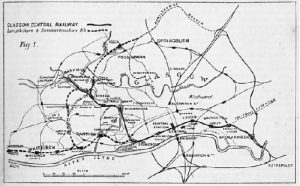
Map showing the routes of the Glasgow Central Railway and the Lanarkshire & Dumbartonshire Railway on both of which Charles worked
In 1890 Charles commenced work on the Glasgow Central Railway which opened in 1896. This line connected the Lanarkshire coalfields to Glasgow’s Queen’s Dock for the Caledonian Railway Co’s system opening up an underground city and suburban line for Glasgow and an extension to their Dumbarton line.
The creation of the underground section was no mean engineering feat as it had to avoid disruption of surface traffic, underground sewers, drains, water and gas pipes, electric cables and necessitated underpinning many important buildings etc. It was considered one of the most important engineering undertakings of its time.
The joining up of the Lanarkshire line to the Dumbarton line allowed considerable industrial and domestic development along the north side of the Clyde in response to the ability to move coal and steel from Lanarkshire. It was not easy work and involved tunnels and city work.
In addition to other minor works, at the time of his death, Charles was working on an extension of the Lanarkshire and Ayrshire Railway so as to allow coal and steel to be moved to Ardrossan port, Barrhead and Paisley.
The Invergarry to Fort Augustus line was also being worked on after many attempts to obtain approval for an extension of the West Highland line to Inverness but was not approved.
Charles had also campaigned vigorously politically against the Clyde Navigation Trust’s monopoly of the River Clyde and power to construct docks. After 3 Parliamentary sessions, the Renfrew Dock and Harbour Extension Bill was passed. This campaign on top of his already heavy work load proved too much for him and his health deteriorated. His last work was in conjunction with Sir John Wolfe Barry, K.C.B. working on the Ballachulish extension of the Callander and Oban Railway.
In the summer of 1900 he suffered an attack of paralysis while in Spain but continued his work. However this attack was followed by further ill health and in 1900 he was forced to give up working and look for rest abroad. He died on 8th February 1901 at Davos Platz, Swizerland at the tender age of 48.
Charles was commercially and politically greatly respected for his vision of the future requirements for mass public travel and even today (2020) people owe him great respect for his contribution to the railway system around the Glasgow area.
ANNA BLYTH GIBSON (1854 – 1906) – wife of CHARLES DE NEUVILLE FORMAN (see above), was born 3rd September 1854 and died 17th October 1906. Charles and Anna were married in Govan, Glasgow on 13 Sep 1880.
ROBERT HANNAY FORMAN (1887 – 1890) – Son of Charles and Anna was born 15th November 1887 and died in childhood on 24th May 1890.
HILDA CHRISTINA FORMAN (1881 – 1890) – Daughter of Charles and Anna was born 8th November 1881 and died in childhood on 31st December 1890
CHARLOTTE OXENBOROUGH RUSH (1800 – 1923) was the first wife of ARTHUR NELSON FORMAN. Whom she married in Edinburgh in 1920. Charlotte died on 7th March 1923 aged 23 after the birth of their daughter Mary Isabel Forman.
MARY ISABEL FORMAN – infant daughter of Arthur & Charlotte Forman was born & died 19th February 1923. Mary Isabel was their second daughter.
[Arthur Nelson Forman (1889 – 1962), husband of CHARLOTTE OXENBOROUGH RUSH (see above) was the son of Charles Forman and ANNA BLYTH GIBSON (see above) is not mentioned on the memorial. The following in italics is from the Glasgow University records with additions in (brackets)
(Educated at Merchiston Castle School, Edinburgh) Arthur Nelson Forman graduated from the University of Glasgow with a BSc in April 1913 and won two Sporting Blues in 1910.
Arthur was born on the 1st of May 1889 in Stirling. His father, Charles Forman, was a Civil Engineer and Arthur appears to have been following in his footsteps, taking courses of Natural Philosophy (Physics), Chemistry, Higher Mathematics and Engineering. Arthur was also a member of the rugby club, playing as either scrum-half or fly-half. Arthur did well and won two sporting blues awards, one for Rugby and one for Fives, in 1910.
During the First World War, Arthur served as Captain in the (85th Field Regiment of) Royal Engineers and entered the war in Salonika (now Thessaloniki/Thessalonika) in February 1916. An international force consisting of British, Serbian, Russian and Italian units, among others, fought against Bulgarians and Austrians in this little known campaign. Originally it had been intended for a British-Franco force to aid the Serbs in their fight against Bulgarian aggression but by the time they landed in late 1915 the Serbs had already been defeated. An attempted Bulgarian invasion of Greece was driven back and fighting continued until 1918.
Arthur served with distinction, earning both a Military Cross and a Croix De Guerre in addition to his service medals of British War Medal and Victory Medal. The Victory Medal was awarded for personnel who served in a theatre of war and the British Army Medal awarded to those who served abroad. The Military Cross was awarded for gallantry during operations and the Croix De Guerre was a medal awarded by the French Government in order to recognise acts of bravery.
Arthur worked as a Civil Engineer after the war and he died on the 16th May 1962 in the town of Callander.]
CONSTRUCTION OF THE WEST HIGHLAND LINE for The West Highland Railway Company
Engineers: Forman and McCall Contractor: Lucas and Laird
The construction of this railway line was exceptionally complicated because of the lack of roads and the crossing of large areas of semi fluid peat bog across Rannoch Moor. The first sod was cut on 23rd October 1889 and the contractors gathered together 5,000 Irish labourers to lay the track. Work progressed until August 1891 when a dispute between the contractor and owners ended up in Dumbarton Sherriff Court. The Contractor claimed that more money should be paid for removal of boulders than other spoil. The Sherriff founded for the owners but by that time most of the Irish labourers had moved to work elsewhere. Work commenced again in October 1891 but only after a negotiated settlement and recruitment of a new labour force consisting of Highlanders, Irishmen, Poles and people from other countries. It was tough and dangerous work and there is a burial ground near Arrochar where 37 men who were killed during construction are buried with a memorial plaque added in 1991.
The particularly boggy 10 mile / 16.093 Kms section of the line across Rannoch Moor was still to be constructed and to begin with, equipment and material sank into the semi-fluid bog. This major problem was solved by creating rafts of brushwood, ash and turf allowing the railway line to ‘float’ across the moor.
The next problem was that by 1893 the West Highland Railway Company was running out of money and was only saved by a Mr Renton who was a wealthy director of the company which allowed the line to Fort William to be opened in 1894 and the 40 mile extension to Mallaig, which had been started in 1897 to be completed in 1901. The contractors for this section were Simpson & Wallace and Sir Robert McAlpine & Sons)
The 100-mile Craigendoran to Fort William section was completed in 1894 and the worst snow storm of the century happened in 1895 resulting in two engines being stuck in the snow at Glen Douglas.
The 40-mile Fort William to Mallaig extension was begun in 1897 and was completed in 1901.
The West Highland line is considered one of the world’s most scenic routes and still (2020) runs a steam train on the Fort William to Mallaig section crossing the famous Glenfinnan viaduct given major publicity in a Harry Potter film.
https://www.youtube.com/watch?v=G20ooYEBviw#t=1680 Glasgow – Fort William – Mallaig Cab view film
https://www.youtube.com/watch?v=sseOyOne7oI Fort William to Mallaig steam train 1959










